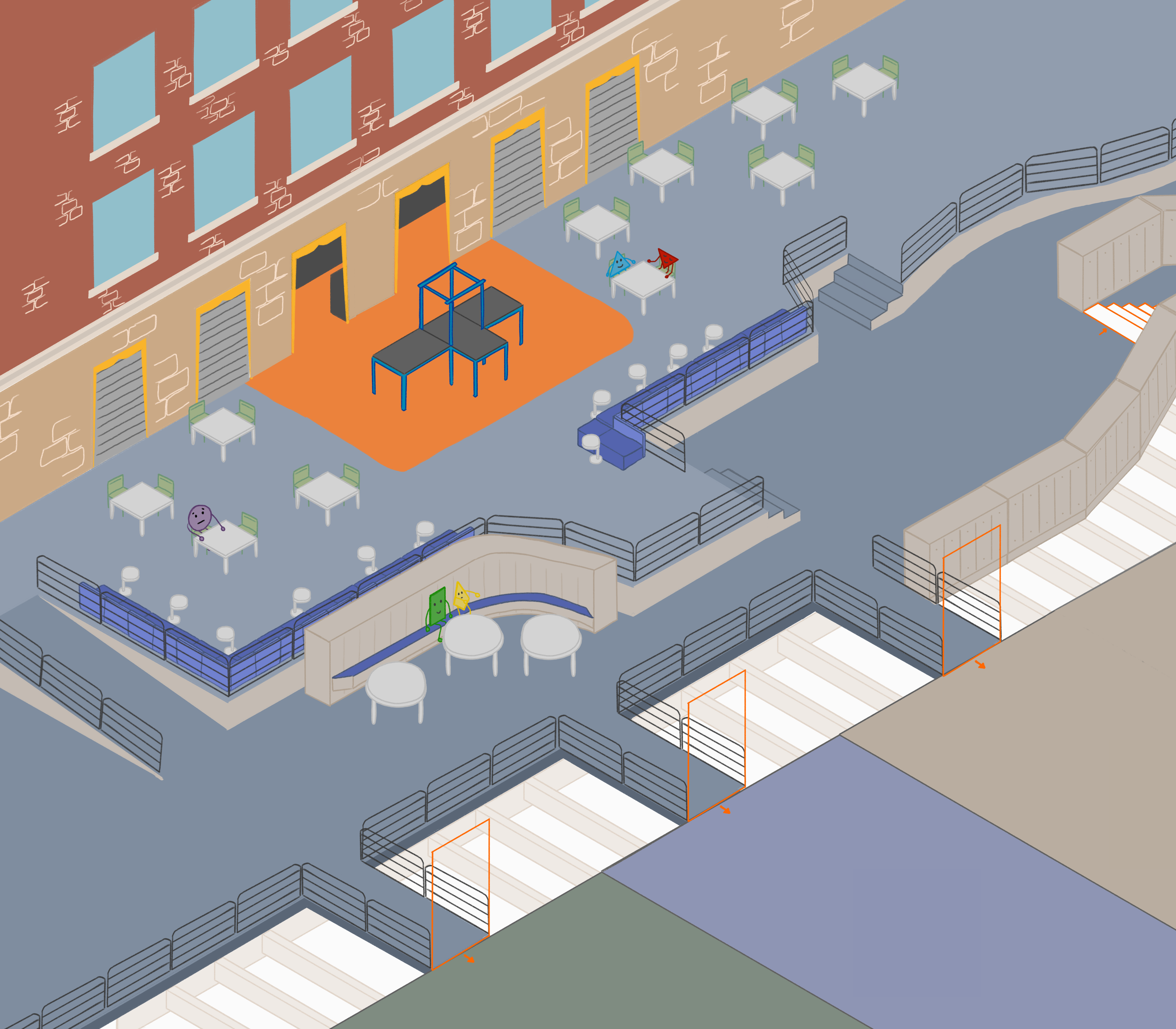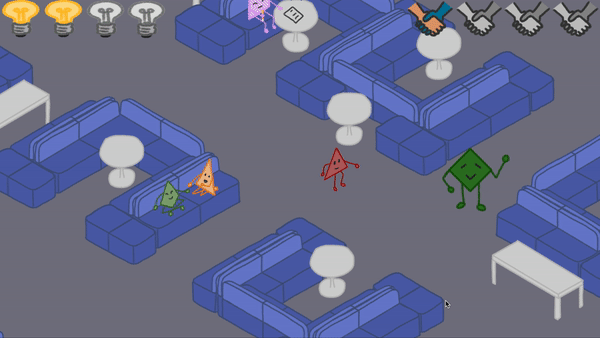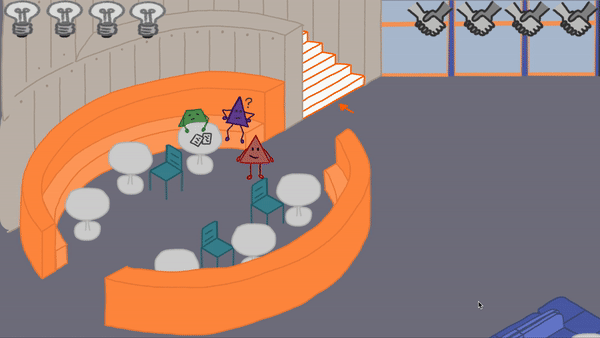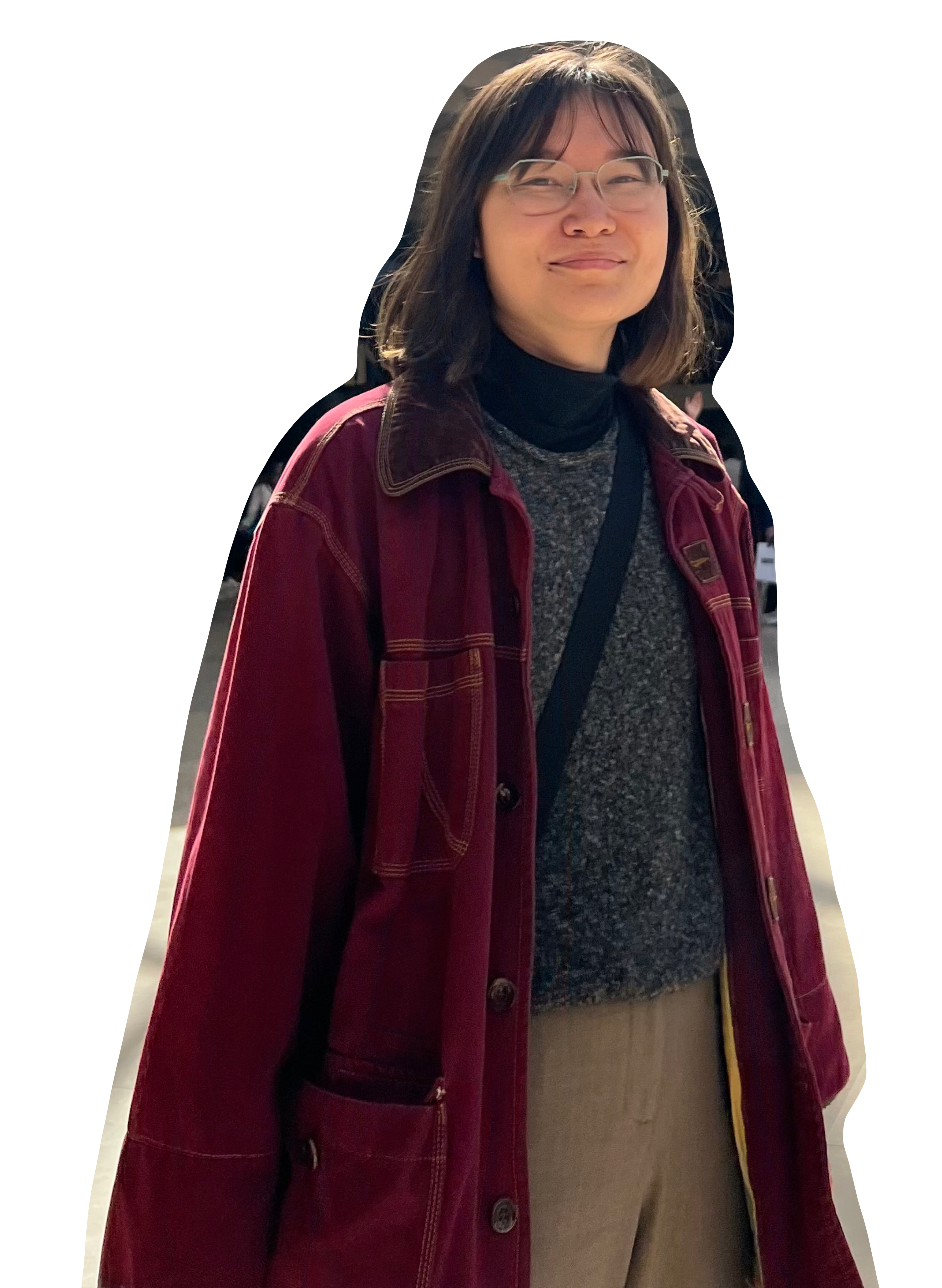STUDYING SHAPES
2D Video Game






Worked for:
3 weeks, Oct 2022
Created by:
Anabelle Mandel and Erika Sampson
Individual Responsibilities:
3 weeks, Oct 2022
Created by:
Anabelle Mandel and Erika Sampson
Individual Responsibilities:
- game design
- 2D art assets for:
Studying Shapes is a 2D video game that I created as a student project to commemorate the 40th anniversary of Wellesley College's computer science department. The development process revolved around the prompt of "centering the experience of being a student at Wellesley." The game is inspired by trivia games and puts players in the role of a computer science student. The goal is to answer questions during office hours for various classes and help fellow classmates with their problems. Our game won first prize at the event.
Development Process:
In the development of Studying Shapes, the first step was ideation and design. Once we had established the core concept, we documented the necessary assets and decided on the visual style. I drew inspiration from the simple coloring book aesthetic of Chicory: A Colorful Tale and the 2D isometric style used in games such as Hades and Into the Breach. Initially, I tried a simple 2D top-down look for the art, but it was challenging to convey dimension and distinguish each object. Therefore, I switched to the isometric style.
The game is set in our college's science center, and I used both reference pictures and personal experiences studying in the building to create the game environment. This included larger background drawings of the two floors of the science center and drawings of the individual classrooms where players would take quizzes.
The UI elements maintain the drawn look present in the environment and connect to the game’s setting. The quizzes' background, the game's title screen, and the instructions for the game controls are all represented as a whiteboard because of the prevalence of whiteboards in the actual science center. The actual science center also has a strong orange and blue theme, which we carried over in the drawn depictions and the color choice for the UI.
As the game's title suggests, the characters are represented as shapes. This decision was partially due to time constraints and also to match the established visual style. I made sure to give each NPC a unique appearance and simple animations to add life to the scene. The player character had more complex animations, such as a walk cycle.
Challenges Faced:
One of the challenges we encountered during the game design process was figuring out how to create a game that accurately represented what it was like to be a computer science student at Wellesley and embodied the core values of the computer science department. We drew on our own experiences taking computer science courses to determine that one of the things we wanted to showcase was the department's emphasis on collaboration. At first, helping your fellow students was not a requirement to complete the game, but we ultimately decided to make it a central part of the gameplay. During the early stages of ideation, we also considered implementing a grading system as a form of reward. However, after careful consideration, we determined that this type of reward system would place undue pressure on players to earn good grades instead of focusing on learning and helping the other characters.
Lessons Learned:
The development of Studying Shapes taught me the importance of time management and playtesting. As an extracurricular project, we had to balance it with our classes, and as the deadline approached, we felt the pressure of crunch. While we managed to complete the game on time, we didn't leave any time for playtesting. It wasn't until the day of the anniversary event, when we watched other people play the game, that we discovered some bugs. Fortunately, the bugs were not game-breaking, but if I had more time, I would have made player feedback an integral part of our development process.
Development Process:
In the development of Studying Shapes, the first step was ideation and design. Once we had established the core concept, we documented the necessary assets and decided on the visual style. I drew inspiration from the simple coloring book aesthetic of Chicory: A Colorful Tale and the 2D isometric style used in games such as Hades and Into the Breach. Initially, I tried a simple 2D top-down look for the art, but it was challenging to convey dimension and distinguish each object. Therefore, I switched to the isometric style.
The game is set in our college's science center, and I used both reference pictures and personal experiences studying in the building to create the game environment. This included larger background drawings of the two floors of the science center and drawings of the individual classrooms where players would take quizzes.
The UI elements maintain the drawn look present in the environment and connect to the game’s setting. The quizzes' background, the game's title screen, and the instructions for the game controls are all represented as a whiteboard because of the prevalence of whiteboards in the actual science center. The actual science center also has a strong orange and blue theme, which we carried over in the drawn depictions and the color choice for the UI.
As the game's title suggests, the characters are represented as shapes. This decision was partially due to time constraints and also to match the established visual style. I made sure to give each NPC a unique appearance and simple animations to add life to the scene. The player character had more complex animations, such as a walk cycle.
Challenges Faced:
One of the challenges we encountered during the game design process was figuring out how to create a game that accurately represented what it was like to be a computer science student at Wellesley and embodied the core values of the computer science department. We drew on our own experiences taking computer science courses to determine that one of the things we wanted to showcase was the department's emphasis on collaboration. At first, helping your fellow students was not a requirement to complete the game, but we ultimately decided to make it a central part of the gameplay. During the early stages of ideation, we also considered implementing a grading system as a form of reward. However, after careful consideration, we determined that this type of reward system would place undue pressure on players to earn good grades instead of focusing on learning and helping the other characters.
Lessons Learned:
The development of Studying Shapes taught me the importance of time management and playtesting. As an extracurricular project, we had to balance it with our classes, and as the deadline approached, we felt the pressure of crunch. While we managed to complete the game on time, we didn't leave any time for playtesting. It wasn't until the day of the anniversary event, when we watched other people play the game, that we discovered some bugs. Fortunately, the bugs were not game-breaking, but if I had more time, I would have made player feedback an integral part of our development process.
